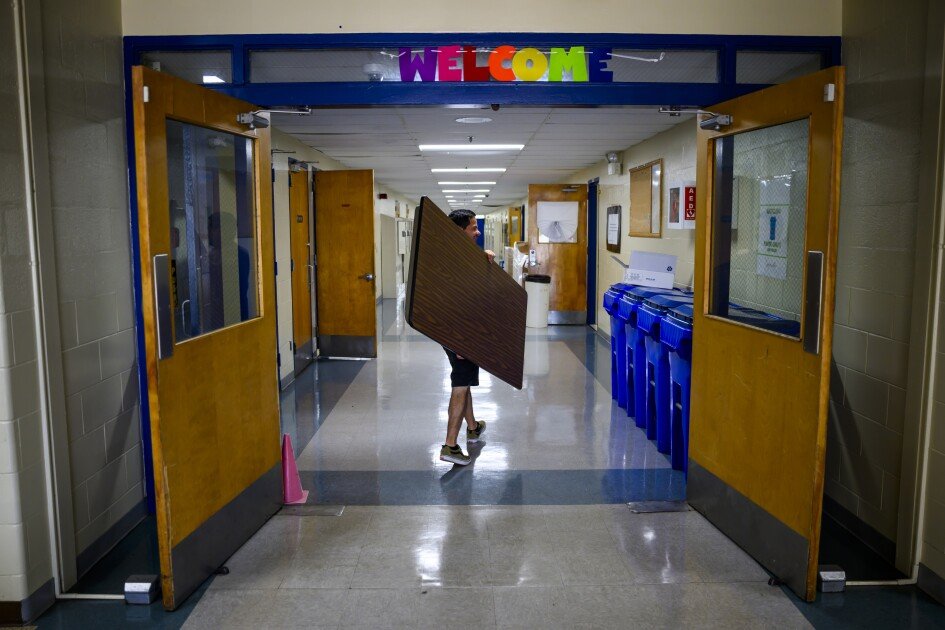As the first day of school approaches, some teachers and students in Washington and surrounding suburbs are preparing for more than fresh pencils and new classmates: They’re packing up their classrooms and moving into temporary “swing spaces.”
Swing spaces are sites where schools temporarily relocate during major renovations and new construction or after building damage. They can be housed in previously shuttered schools, or purpose-built multiuse facilities, or in trailers and mobile classrooms.
Over the past decade, the District of Columbia school system has had about 150 modernization, renovation, or construction projects at schools, shuffling entire communities in and out of swing spaces—sometimes for more than a school year.
But school and district leaders say the upheaval doesn’t have to derail learning or crush morale. The key? Advance planning, clear communication, and small touches that make the temporary feel permanent.
“When we moved in, it was really important to make the space feel comfortable and homelike,” said Malaika Golden, the principal of D.C.’s Whitlock Elementary School, which operated out of an old school building repurposed as a swing space for two years. “We did a lot of decorating. We made sure everything was unpacked and put away. It didn’t look or feel like a temporary space.”
While no move is without its bumps, Golden and other seasoned educators shared practical strategies for managing swing spaces and easing the transition.
Hold space and allocate time for the adjustment
Alicia Hart, the chief operating officer for the Alexandria City public schools in Virginia, said the district usually gives staff and families at least a school year’s notice before a swing space transition.
“We start communication early, and we do a lot of communication with families and with staff because we want them to understand the purpose behind why we are doing the swing space,” she said.
District leaders attend parent-teacher association and community meetings, and maintain updated websites with swing-space details. They also outsource moving as much as possible, so staff aren’t left hauling boxes. Hart’s team meets with teachers individually to label classroom materials, then hires movers to handle packing.
“We generally tend to move into swing spaces over the summer,” Hart said, which minimizes disruption to student learning.
Questions to consider when choosing your swing space
Jason Washington, the associate superintendent of supporting services for Prince George’s County public schools in Maryland, considers these five factors when relocating a school to a swing space.
- Proximity: How close is the swing space to the home school?
- Size: Can it house the full student body? If not, will students be moved in phases?
- Transportation: Can bus routes be reorganized efficiently?
- Timing: What other schools are moving, and how will that affect availability?
- School type: Does it support special programs or certain grade spans?
Having a swing space within a district can save costs in the long run.
Washington said the district prefers to use refurbished vacant buildings as swing spaces. But when none is available nearby, leasing becomes necessary.
When selecting a swing space, Washington’s top priorities are proximity to the school community, sufficient size, age-appropriate facilities, and capacity for special programs.
Make yourself feel at home
District leaders told Education Week it is important to keep routines and visuals consistent with the old building—same decorations, same expectations, same look and feel—so students feel grounded.
In Prince George’s County, parents often ask whether swing spaces can still offer all the academic programs available in the home school.
“What parents want to know is: ‘Are all of the programs that we are getting at the school currently, are we still able to get those in the swing space?’” Washington said. The answer, he said, is always yes.
For one arts-focused high school, that meant moving the photography darkroom and buying a portable dance floor that can be reused.
Manage transportation changes
Proximity matters in part because transportation can be a headache. If a district spans a wide area, it should consider consolidating bus routes where possible, district leaders said.
Whitlock Elementary’s swing space was a short bus ride—about 6 or 7 minutes—from its original building. Still, some families were uneasy, especially those used to walking. A few opted to transfer and rejoin the school after renovations.
To ease concerns, Golden said staff members volunteered to stay late and help supervise busing, placing two or three adults on each bus in addition to the driver.
Focus on the light at the end of the tunnel
Displacement is easier to handle when communities can picture the reward: brand-new facilities.
Prince George’s County’s Washington emphasized the importance of sticking to construction timelines and following through on promises to families.
During Whitlock Elementary’s swing-space stint, parents stayed engaged in the modernization process, eager to see the transformation. “It was even a retention strategy,” Golden said.
“You go through setting up and making sure things feel like home,” she added, “and the next thing you know, you’re back to packing up again.”







